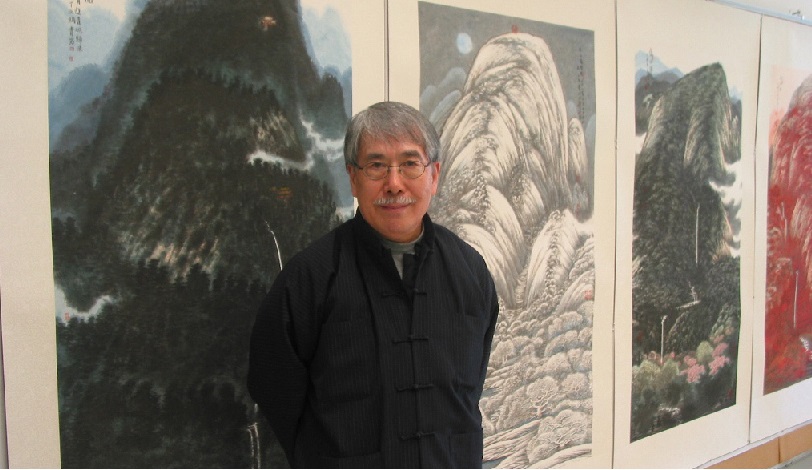Art Issues
- Latest NewsThe latest article on a special issue topic is below. Other articles on the same topic can be read by clicking on the 'Archive' year and month on the side-bar.
Obituary: Wan Qingli 萬青力 (1945-2017)
陳蓓 Pedith Chan, Assistant Professor, Cultural Management Programme, The Chinese University of Hong Kong
at 3:31pm on 22nd February 2017

Professor Wan Qingli (Photograph courtesy of Academy of Visual Arts, Hong Kong Baptist University).
(國際藝評人協會香港分會成員、著名中國藝術史學家及藝術家萬青力於2017年1月11日在美國因病逝世,享年71歲。)
Wan Qingli, a member of the International Art Critics Association Hong Kong (AICAHK), scholar and celebrated artist in the field of Chinese art recently died in the United States. Professor Wan was a member of the generation born just after World War II and only a few years before the establishment of the People’s Republic of China. He experienced political and social upheaval at an early age, which paved a unique path for his later academic and artistic pursuits.
During the Cultural Revolution, shortly after obtaining his first degree from the Department of Art History at the Central Academy of Fine Arts in 1968, Wan was imprisoned in a ‘cowshed’, where he befriended Li Keran, Li Kuchan, Wo Zouren and Huang Yongyu. Then he was sent to a labour camp. After being ‘re-educated’, he served as a painter at the Beijing Art Academy and studied painting with Li Keran and Lu Yanshao in the late 1970s. In 1981, he completed a Master’s degree in Chinese painting at the Central Academy of Fine Arts and left China in 1984 to pursue a PhD in art history in the United States, under the supervision of leading scholar Li Chu-Tsing. In 1989, Wan took up an academic position in the Department of Fine Arts at the University of Hong Kong, where he supervised over twenty postgraduate students. In 2006, after retiring from the University, Wan took up the posts of Founding Director and Chair Professor of Visual Arts in the newly established Academy of Visual Arts at the Baptist University of Hong Kong, where he retired in 2012.
As one of the few art historians to focus on twentieth-century Chinese art in the early 1990s, Wan offered a new perspective on the development of art in China in the latter half of the twentieth century, when the country had cut itself off from the outside world. With particular reference to Chinese artists who practised Chinese ink painting, such as Huang Binhong, Li Keran, Lu Yanshao, Chen Xiaodie, Wan reasserted the accomplishments of Chinese artists during this turbulent era. Co-authored with Li Chu-Tsing, his book The Century Was Not Declining in Art: A History of Nineteenth-Century Chinese Painting focuses on the development of Chinese painting in the late nineteenth and early twentieth centuries, challenging the prevailing impact-response model. He re-evaluated the art and artists that had been overlooked in the standard modern Chinese art history and argued convincingly for the value of Chinese painting by offering a different perspective for us to understand Chinese modernity, rescuing our understanding of the period’s art from Western-centred paradigms.
Wan’s assertion of the value and potential of Chinese art was put into practice in his own art. Although artistic practice has long been regarded as a form of cultural capital in the field, the specialisation that has taken place in art education since the early twentieth century has allowed few art historians the luxury of being able to practise art. However, Wan’s unique training in both the practice and history of art in China as well as the United States equipped him to cultivate a personal style. His artworks reflect his personal trajectory and inner world. Five years of substantial training in art history in the United States not only laid a solid foundation for his academic career, but allowed him to visit scenic sites in the United States, which enriched and provided a source of inspiration for his artwork. Breaking away from the Chinese tradition of ‘elite’ art, Wan injected a contemporary spirit into his painting by masterfully incorporating current issues into his work. His satirical paintings, mostly made in Hong Kong during his professorship at the University of Hong Kong, are well known. In these paintings, Wan integrated Cantonese slang with social issues, extending the boundaries of traditional genres.
He was a prolific art historian and an artist. Wan’s experience of a turbulent time in China’s history left scars on his soul, but ultimately gave birth to his unique academic and artistic accomplishments. Following the path of a traditional man of letters, he created an ideal dreamland via the genre of landscape painting, in which he could escape from the dusty world and enjoy the tranquillity and calm brought by art. He is now resting in that utopia. Wan’s death is a great loss to the Hong Kong art world and we hope that ‘though miles apart, could men but live forever. Dreaming they shared this moonlight endlessly’. He will be very much missed.
